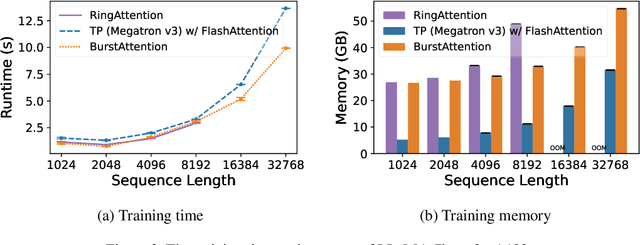Sun Ao
APB: Accelerating Distributed Long-Context Inference by Passing Compressed Context Blocks across GPUs
Feb 17, 2025Abstract:While long-context inference is crucial for advancing large language model (LLM) applications, its prefill speed remains a significant bottleneck. Current approaches, including sequence parallelism strategies and compute reduction through approximate attention mechanisms, still fall short of delivering optimal inference efficiency. This hinders scaling the inputs to longer sequences and processing long-context queries in a timely manner. To address this, we introduce APB, an efficient long-context inference framework that leverages multi-host approximate attention to enhance prefill speed by reducing compute and enhancing parallelism simultaneously. APB introduces a communication mechanism for essential key-value pairs within a sequence parallelism framework, enabling a faster inference speed while maintaining task performance. We implement APB by incorporating a tailored FlashAttn kernel alongside optimized distribution strategies, supporting diverse models and parallelism configurations. APB achieves speedups of up to 9.2x, 4.2x, and 1.6x compared with FlashAttn, RingAttn, and StarAttn, respectively, without any observable task performance degradation. We provide the implementation and experiment code of APB in https://github.com/thunlp/APB.
BurstAttention: An Efficient Distributed Attention Framework for Extremely Long Sequences
Mar 14, 2024



Abstract:Effective attention modules have played a crucial role in the success of Transformer-based large language models (LLMs), but the quadratic time and memory complexities of these attention modules also pose a challenge when processing long sequences. One potential solution for the long sequence problem is to utilize distributed clusters to parallelize the computation of attention modules across multiple devices (e.g., GPUs). However, adopting a distributed approach inevitably introduces extra memory overheads to store local attention results and incurs additional communication costs to aggregate local results into global ones. In this paper, we propose a distributed attention framework named ``BurstAttention'' to optimize memory access and communication operations at both the global cluster and local device levels. In our experiments, we compare BurstAttention with other competitive distributed attention solutions for long sequence processing. The experimental results under different length settings demonstrate that BurstAttention offers significant advantages for processing long sequences compared with these competitive baselines, reducing 40% communication overheads and achieving 2 X speedup during training 32K sequence length on 8 X A100.
The RoboDepth Challenge: Methods and Advancements Towards Robust Depth Estimation
Jul 27, 2023



Abstract:Accurate depth estimation under out-of-distribution (OoD) scenarios, such as adverse weather conditions, sensor failure, and noise contamination, is desirable for safety-critical applications. Existing depth estimation systems, however, suffer inevitably from real-world corruptions and perturbations and are struggled to provide reliable depth predictions under such cases. In this paper, we summarize the winning solutions from the RoboDepth Challenge -- an academic competition designed to facilitate and advance robust OoD depth estimation. This challenge was developed based on the newly established KITTI-C and NYUDepth2-C benchmarks. We hosted two stand-alone tracks, with an emphasis on robust self-supervised and robust fully-supervised depth estimation, respectively. Out of more than two hundred participants, nine unique and top-performing solutions have appeared, with novel designs ranging from the following aspects: spatial- and frequency-domain augmentations, masked image modeling, image restoration and super-resolution, adversarial training, diffusion-based noise suppression, vision-language pre-training, learned model ensembling, and hierarchical feature enhancement. Extensive experimental analyses along with insightful observations are drawn to better understand the rationale behind each design. We hope this challenge could lay a solid foundation for future research on robust and reliable depth estimation and beyond. The datasets, competition toolkit, workshop recordings, and source code from the winning teams are publicly available on the challenge website.
 Add to Chrome
Add to Chrome Add to Firefox
Add to Firefox Add to Edge
Add to Edge